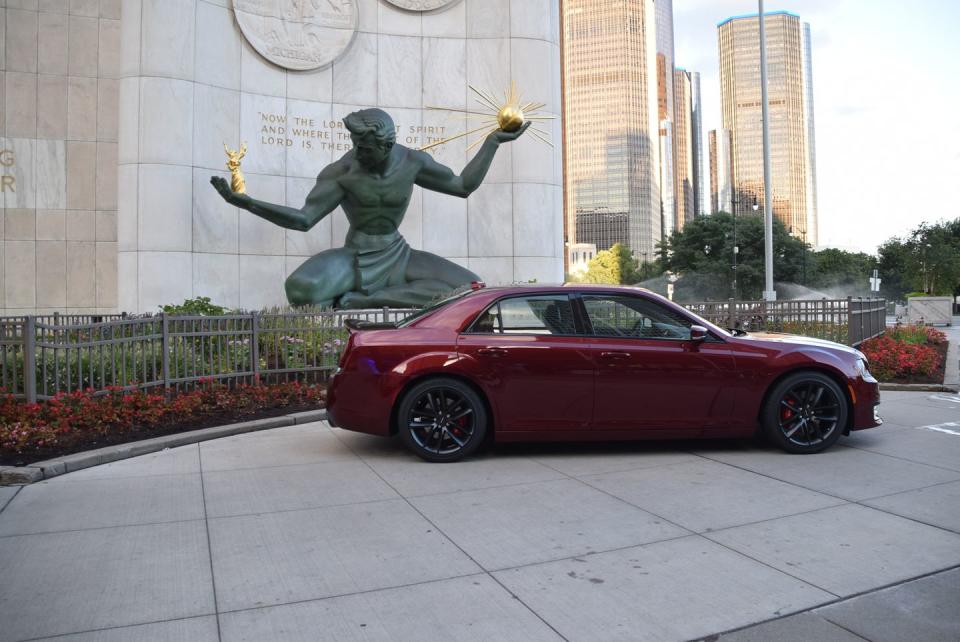Tavares Talks Up Dodge, Chrysler Brands, Even as Models Disappear

"Hearst Magazines and Yahoo may earn commission or revenue on some items through the links below."
The Chrysler and Dodge product lineups have been gutted over the course of many years.
But Stellantis CEO Carlos Tavares (above) is upbeat about the future of both brands—and all 14 Stellantis brands—because they’re all making money, he tells journalists this week.
While it’s important to remain humble, Tavares also said Stellantis “will be the only credible challenger to Tesla—you will see that.”
Reading the tea leaves in Detroit for the past month, one might have serious questions about the viability about two storied brands—Chrysler and Dodge—that have been joined at the hip since the former acquired the latter in 1928.
Since then, the two brands have reinvented themselves multiple times with the introduction of small cars, family cars, minivans, convertibles, performance cars, crossover, and SUVs—some better received than others.
The passing of time, however, has gutted each brand’s lineup. Dodge’s pickup trucks are now part of Ram, and the Challenger coupe and Charger sedan will be gone next year, leaving only the Durango SUV and 2023 Hornet compact crossover in the lineup.
Things appear to be even more dire for the Chrysler brand. When the 300 sedan ends production next year (on the same platform as the Challenger/Charger), Chrysler will have only the Pacifica minivan carrying the brand shield. Look back 15 years, and Chrysler had seven different models in the portfolio; 10 years ago, that number fell to three.
This kind of paring is familiar—it happened before the demise of Oldsmobile, Plymouth, Mercury, Saturn, and countless other discontinued brands. To date, parent company Stellantis has announced an all-electric Dodge Charger Daytona SRT concept as a preview of a production model arriving by 2024.
Such a promise has not yet been made on the product front for Chrysler, even though Stellantis promises Chrysler will launch its first battery-electric vehicle in 2025—perhaps a production version of the Chrysler Airflow concept—and will have a full battery-electric portfolio by 2028.

Chrysler and Dodge are only two of the 14 brands within the Stellantis group globally, and CEO Carlos Tavares sounds quite optimistic about the future for these two legacy US brands, based on his comments to journalists this week during the North American International Auto Show in Detroit.
“I am a happy CEO,” he said in response to a question about how Stellantis is managing so many automotive brands, which include Peugeot, Alfa Romeo, and Fiat in Europe. “I am a privileged guy looking at fantastic things being done brand by brand.”
He chuckles about the question he often gets about whether it’s possible to equally “love all 14 of your kids.” But he says the “level of passion is sky high” at each brand within Stellantis, and that his main task is “giving them guidelines to avoid repeating the mistakes I’ve made myself during my career.”

Tavares didn’t provide financial details, but he said all 14 Stellantis brands (which in the US also include Jeep and Ram) are on sound footing.
“All of our brands are now making money—no exception—improving their earnings, improving financial results,” he told journalists, noting that the revenue stream feeds further product investments and marketing communication. “The company is being able to monetize the value we create. We give a runway to each brand.”
He went through the North American portfolio, referring to the obvious asset strengths of the Jeep and Ram brands, but then talking up Chrysler and Dodge, despite the outward signs of trouble.

“We’ve had questions about the positioning of Chrysler,” he said, noting the stature of that luxury brand has been changing for decades. When the Chrysler rebound plan is fully baked, Tavares said Chrysler Brand CEO Christine Feuell will explain it.
As for Dodge, Tavares said the brand best known for muscle cars is “making a fantastic transformation,” and that converting the brand to full electrification “will give even more American muscle to the brand.”
The profitability of Dodge and Chrysler—which must be thin considering how many vehicles are involved—makes all the difference. “As long as we are making money, we don’t have to rush. I can testify to what I see,” Tavares said, referring to employee passion and talent. He referred to “sometimes gloomy, chaotic times,” but then declared, “I am not worried (because) I know I have the people to overcome all this.”

And while it’s important to remain humble, Tavares also said Stellantis “will be the only credible challenger to Tesla—you will see that.”
On that electrification front, Tavares said Stellantis is investing $35 billion over the next five years in software and battery-electric vehicles, which represents half of the company’s intended R&D spend, with plans to have an all-electric vehicle portfolio in Europe by 2030, while in North America the goal is to reach 50% by 2030.
While Stellantis is clearly lagging cross-town rivals Ford and General Motors, which already have EVs in the US market, Tavares said Stellantis will start next year with a ProMaster all-electric commercial van, to be followed by at least 25 all-electric vehicles by decade’s end.
Are you confident or concerned about the future of the Dodge and Chrysler brands in the US? Please comment below.

 Yahoo Autos
Yahoo Autos 